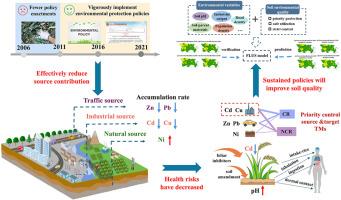政策驱动的金属污染减少:一个典型工业城市农业用地面向源头的健康风险和预警证据
IF 10
1区 环境科学与生态学
Q1 ENGINEERING, ENVIRONMENTAL
引用次数: 0
摘要
为了保护公众健康,中国出台了几项严格的环境保护措施,以应对有毒金属(TMs)带来的风险。然而,政策实施对减少污染的效果仍不明朗。在此基础上,通过对2006 - 2021年典型工业城市土壤-水稻系统TMs的时空动态监测,分析TMs的来源健康风险,探讨政策实施对土壤-水稻系统污染的缓解效果(2006 - 2010年:政策实施初期;2011-2015:开发阶段;2016-2021年:强化阶段)。在强化政策实施后(2016-2021年),主要来自工业活动的Cd和Cu的累积率分别降至- 0.161和0.007 mg kg - 1年- 1。与此同时,以交通污染源为主的铅含量在2021年降至33.34 mg kg−1。随着稻米中镉的平均含量从2011年的峰值0.16 mg kg - 1降至2021年的0.09 mg kg - 1,人类健康风险也有所降低。然而,尽管工业来源对所有人口的癌症和非癌症风险的贡献有所减少,但它们仍然构成最高的健康风险。基于土壤环境质量预测模型,随着政策的持续实施,预计2030年和2050年中国土壤污染面积比例将分别降至10.21%和8.77%。研究表明,不同排放源和不同政策实施情况下,TM污染水平和健康风险存在差异,需要有针对性地控制污染源,采取相应的修复措施,以减轻环境污染和健康负担。本文章由计算机程序翻译,如有差异,请以英文原文为准。


Policy-driven reduction in metal pollution: Evidence from source-oriented health risks and early warnings in the agricultural land of a typical industrial city
To protect public health, China has issued several strict environmental protection initiatives to address the risks posed by toxic metals (TMs). However, the effect of policy implementation on pollution reduction is still unclear. Herein, the spatiotemporal dynamics of TMs were monitored, and their source-oriented health risks were analyzed to explore the effect of policy implementation on mitigating pollution in the soil-rice system of a typical industrial city from 2006 to 2021 (2006–2010: Initial stage of policy implementation; 2011–2015: Development stage; 2016–2021: Strengthening Stage). After intensive policy implementation (2016–2021), the accumulation rates of Cd and Cu, primarily originating from industrial activities, decreased to −0.161 and 0.007 mg kg−1 yr−1, respectively. Meanwhile, the Pb content, mainly originating from traffic pollution sources, decreased to 33.34 mg kg−1 in 2021. Human health risks also decreased with the decrease in the mean Cd content in rice from its peak of 0.16 mg kg−1 in 2011 to 0.09 mg kg−1 in 2021. However, despite the reduction in the contribution of industrial sources to cancer and non-cancer risks for all populations, they still pose the highest health risk. Based on the soil environmental quality prediction model, the percentage of contaminated soil areas is expected to shrink to 10.21 % and 8.77 % in 2030 and 2050, respectively, with continued implementation of policies. This study reveals that the TM contamination level and health risks varied depending on the emission source and the implementation of policies, which highlighted the need for targeted control of pollution sources and appropriate remediation measures to mitigate environmental pollution and health burdens.
求助全文
通过发布文献求助,成功后即可免费获取论文全文。
去求助
来源期刊

Journal of Cleaner Production
环境科学-工程:环境
CiteScore
20.40
自引率
9.00%
发文量
4720
审稿时长
111 days
期刊介绍:
The Journal of Cleaner Production is an international, transdisciplinary journal that addresses and discusses theoretical and practical Cleaner Production, Environmental, and Sustainability issues. It aims to help societies become more sustainable by focusing on the concept of 'Cleaner Production', which aims at preventing waste production and increasing efficiencies in energy, water, resources, and human capital use. The journal serves as a platform for corporations, governments, education institutions, regions, and societies to engage in discussions and research related to Cleaner Production, environmental, and sustainability practices.
 求助内容:
求助内容: 应助结果提醒方式:
应助结果提醒方式:


